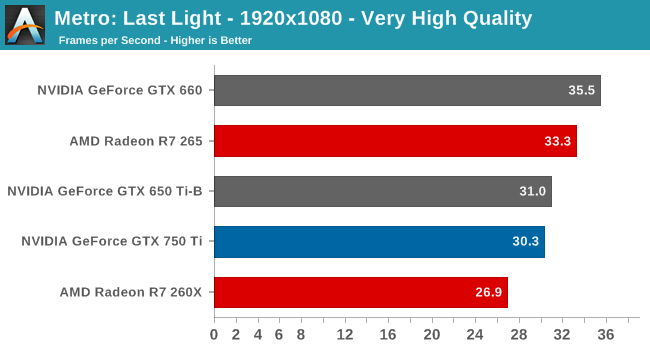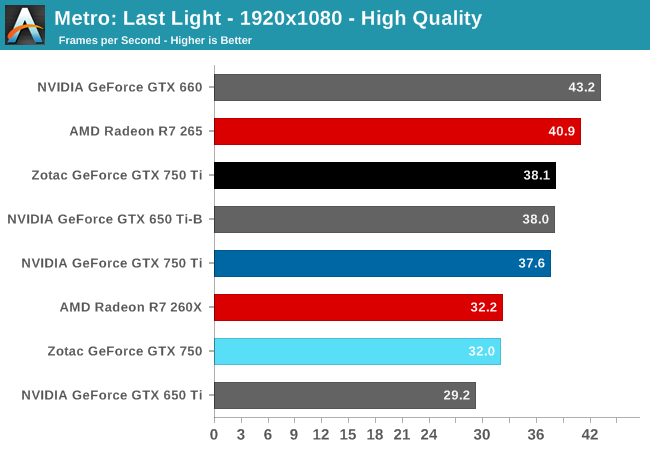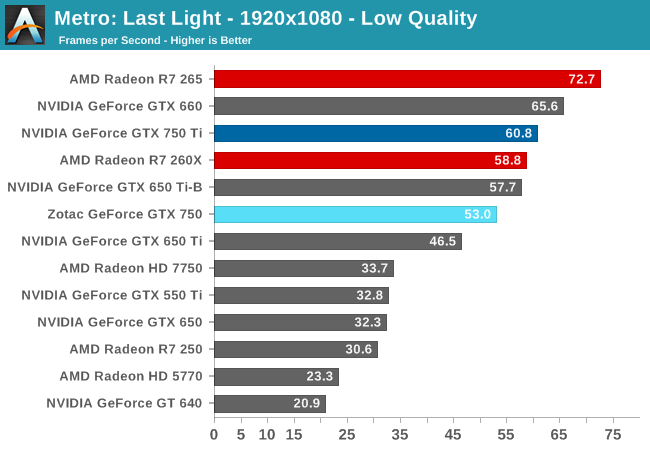The NVIDIA GeForce GTX 750 Ti and GTX 750 Review: Maxwell Makes Its Move
by Ryan Smith & Ganesh T S on February 18, 2014 9:00 AM ESTMetro: Last Light
As always, kicking off our look at performance is 4A Games’ latest entry in their Metro series of subterranean shooters, Metro: Last Light. The original Metro: 2033 was a graphically punishing game for its time and Metro: Last Light is in its own right too. On the other hand it scales well with resolution and quality settings, so it’s still playable on lower end hardware.



Diving into our performance analysis, we’ll be looking at a few different factors. On a competitive basis, the GTX 660 and the R7 265 are the GTX 750 Ti’s closest competitors. Though we’ll also want to compare it to GTX 650, so see what a GK107 versus GM107 matchup looks like. Meanwhile the GTX 750’s closest competitors will be the R7 260X, and to a lesser degree the GTX 650 Ti.
Being one of our more difficult games, Metro shows right off the bat that these mainstream video cards, no matter how fast they are, will face a difficult time. The GTX 750 Ti can stay comfortably above the 30fps at high quality, but the GTX 750 not so much.
What’s clear right off the bat two is two things. The first is that GTX 750 Ti, the GM107 flagship, is significantly faster than GTX 650, the GK107 flagship. GTX 750 Ti is just short of doubling GTX 650’s performance in this benchmark.
The second point is that neither GTX 750 series card is going to fare well against its AMD counterpart. Both the R7 265 and R7 260 are faster than the GeForce cards, and by over 10% at times.
Finally, GTX 750 Ti won’t be touching GTX 660 here. It’s close, but especially at higher quality settings the GTX 660 is pulling away. GTX 750 Ti can’t completely make up for the lack of memory bandwidth and ROP throughput.










177 Comments
View All Comments
Harag - Thursday, March 6, 2014 - link
Not true at all. The release of the Titan showed they could unlock FP64 performance on a specific architecture. The Titan Black also has amazing FP64 performance. You may also want to look into their Quadro line.kwrzesien - Tuesday, February 18, 2014 - link
Cards are available on Newegg! Check out this EVGA Superclocked (1268MHz) with a dual-fan ACX cooler and 6-pin PCIe power connector: http://www.newegg.com/Product/Product.aspx?Item=N8...Frenetic Pony - Tuesday, February 18, 2014 - link
Maxwell is designed for mobile gaming, in which case who cares? Broadwell looks to improve performance per watt at least as much as Maxwell if Intel's initial hints of 30% power improvement for 14nm and 40% improvement for gpu power efficiency pan out. And they were already damned good.But Maxwell isn't designed for high end, in which case GCN 1.1 and AMD are already beating them for price for performance. Congrats Nvidia, you're second place in both categories if this card is anything to go by. I hope to hell your Titan 2 or whatever kicks more ass than this card.
varad - Wednesday, February 19, 2014 - link
@FreneticPony, statements like "Maxwell is designed for mobile gaming" and "But Maxwell isn't designed for high end" tell us you know precious little. Maxwell is an architecture that will span across all of Nvidia's products [Tegra, GeForce, Quadro and Tesla].Frenetic Pony - Thursday, February 20, 2014 - link
Err... they intend to produce as such yes. But it's obvious the architecture itself is targeted squarely at mobile. Power constraints don't actually get in the way as much as other constraints do on the high end. Who really cares if it's 150+ tdp if it's gaming? You get constrained by memory latency and other things no matter how high you can clock it up.This appears to be Nvidia's version of Haswell, concentrated solely on improving performance per watt rather than performance at all. Which is bad timing as Intel is doing the same, but integrates it's GPUs right onto the chip, making them cheaper and smaller than any dedicated card for a laptop is going to be. Meanwhile AMD is crushing Nvidia in both compute and high end gaming performance on the desktop for performance per $.
True, this will help mitigate electricity cost. for compute based work. But as others pointed out not by much. Meaning Nvidia stuck itself with the wrong focus at the wrong time. Maybe it will help with their Tegra SOCs, if they're lucky they'll get back into the game, as Qualcomm soundly crushed the Tegra 4 for third party ARM Socs over the last year.
So, no, it's designed for high end. Doesn't mean they're not going to do it anyway.
Frenetic Pony - Thursday, February 20, 2014 - link
I.E. it really doesn't matter how well they did at what they're doing. Because Intel has done just as well and has built in advantages for its market, what their doing doesn't help that much against AMD in the high end market, and this leaves their only chance for financial success with it being next years Tegra SOCs.ninjaquick - Thursday, February 20, 2014 - link
Plus, AMD is easily capable of taking Nvidia on at the low end with better hardware across the board, more integrated designs, etc.willis936 - Thursday, February 20, 2014 - link
Pro tip: you're always TDP limited. Increasing performance per watt IS increasing performance.Harag - Thursday, March 6, 2014 - link
Broad statements like "AMD is crushing Nvidia..." only proved @Varad correct. you know precious little.HisDivineOrder - Wednesday, February 19, 2014 - link
nVidia fits a lot more performance in a little more space at a lot less power and you think they're doing poorly? This is on the same node.Imagine what they'll pack into a smaller node.
Their focus is probably the right one, given the fact they want to migrate these cores into Tegra.